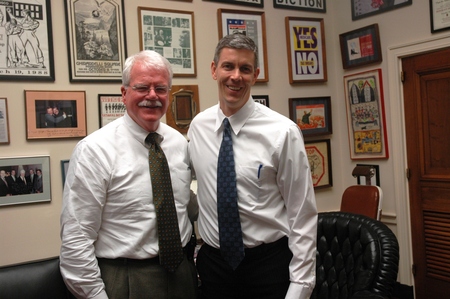WASHINGTON, D.C. – Protecting health care workers, first responders, and other employees on the frontlines of a pandemic outbreak is key to strengthening the nation’s ability to fight viral outbreaks and keep the public safe, experts told the House Education and Labor Committee today.
The witnesses were testifying before the committee at a hearing examining how the current H1N1 flu outbreak has challenged schools, childcare centers, colleges, and workplaces.
“This outbreak has proven that a pandemic can have a ripple effect on our communities,” said
U.S. Rep. George Miller (D-CA), chairman of the House Education and Labor Committee. “In many cases, our morphing public health needs simply don’t align with our education and business needs. Especially in this economy, it’s critical to ensure that when an outbreak hits, students can keep learning and businesses and workers can continue to help move our economy forward.”
While proper planning by schools and businesses and a well-coordinated response by the Obama administration have been effective in helping reduce the threat of this outbreak, additional tools are needed to better protect school and workplace environments from future, imminent pandemics. Experts are predicting that a stronger strain of the H1N1 virus or a similar strain could hit again this fall.
“While events have progressed with great speed, this will be a marathon, not a sprint,” said
Dr. Anne Schuchat, the Interim Deputy Director for Science and Program at the Centers for Disease Control. “Even if this outbreak yet proves to be less serious than we might have initially feared, we can anticipate that we may have a subsequent or follow-on outbreak several months down the road.”
Witnesses urged the importance of ensuring that workers on the frontlines of a pandemic, such as health care workers and first responders, must be able to stay healthy and on the job when an outbreak hits.
Created with Admarket's flickrSLiDR.
“Our frontline healthcare workers are the foundation upon which our health care system is built,” said
Jordan Barab, the Acting Assistant Secretary, Occupational Safety and Health Administration. “If they are not able to work due to illness, or unwilling to work due to fears for their health, individual patients and the country’s entire health care structure will suffer.”
A recent survey of almost 200,000 U.S. health care workers found that 57 percent of these workers had not been provided training on pandemic flu. More than half of these workers felt that their facility was not “ready for most things” that could arise in a flu pandemic. And only 33 percent thought that most health care workers would report to work during an actual flu pandemic.
“Currently there is no comprehensive federal standard to require employers to protect health care workers from an airborne virus like H1N1 or tuberculosis,” said
Miguel Antonio Garcia, a registered nurse in Los Angeles who has been treating patients for the current outbreak. “Protecting these workers will preserve our surge capacity to treat the infected.”
Garcia also emphasized the need for better protective equipment for health care workers, like respirators specifically designed to protect against transmissible airborne viruses.
While OSHA has issued guidance and even has some specific standards relevant to pandemic flu, the agency does not have a mandatory standard that comprehensively addresses the workplace hazards posed by airborne transmissible diseases.
Current federal sick leave policies also present significant challenges for workers, both when dealing with their own health and safety and when finding care for their children if schools close.
The Family Medical Leave Act does not require employers to provide paid sick leave benefits, and not all workers quality for FMLA leave. Fifty-seven million Americans have no paid sick leave, including as many as 86 percent of food service workers. Almost 100 million Americans have no paid sick leave to care for a child.
Even a worker who does have coverage has no right to leave to take care of a non-infected child whose school was closed due to an outbreak.
Many closed schools have yet to re-open. As of Tuesday, approximately 726 schools had closed, affecting 468,000 students, said
Bill Modzeleski, the Associate Assistant Deputy Secretary of the Office of Safe and Drug-Free Schools at the U.S. Department of Education. By Wednesday 140 schools had re-opened. The Department also anticipates that 278 schools will have reopened by today, returning 150,000 children to school.
While communication has been strong between school districts and federal, state and local public health and education agencies throughout this outbreak, the current lack of a central reporting system has made it harder for some officials to track school closures.
“We discovered that we did not have a system in place to track and report the individual schools that had been ordered to dismiss students due to H1N1. My office is working with the County Offices of Education to developing an easy-to-use reporting process so that the state could be kept up to date about any school impacted by an order to dismiss,” said
Jack O'Connell, the Superintendent of Public Instruction for California Department of Education, where many of the nation’s first school closures occurred. He also cited a shortage of school nurses as an obstacle to fighting the outbreak on campuses.
For more information about protecting health care workers from pandemic flu,
click here.
